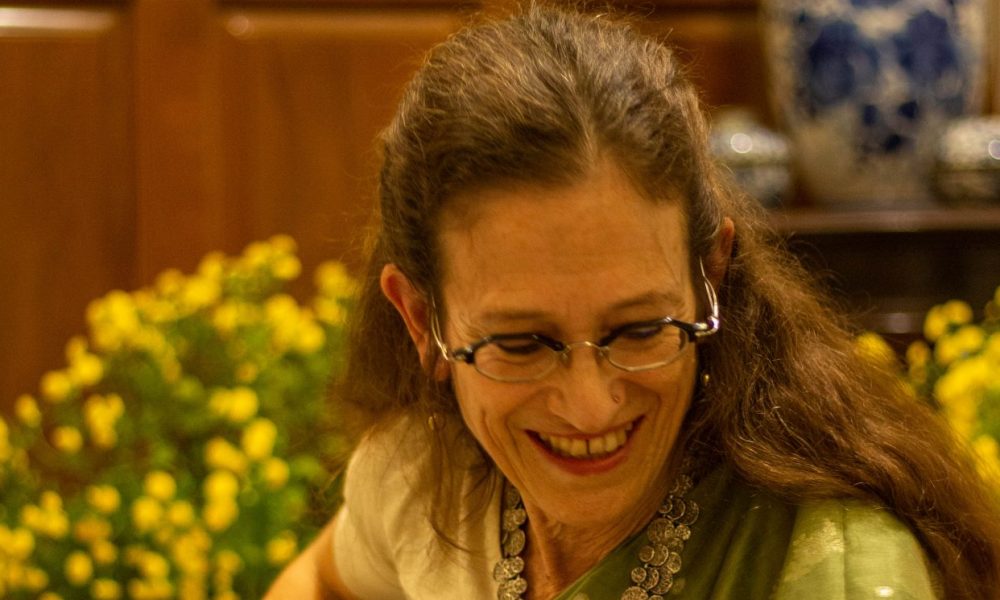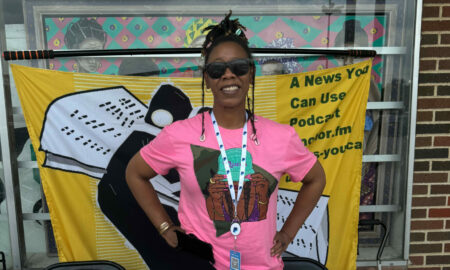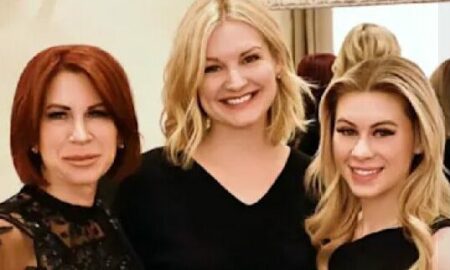

Today we’d like to introduce you to Amie Maciszewski.
Amie, please share your story with us. How did you get to where you are today?
Intercultural communication and celebration of difference through the arts and learning has always been part of my life. Growing up in rural New Mexico in a Polish immigrant family, I was exposed to at least three cultures and languages, which fascinated me and made me curious to know more about the world. It’s been a long, fulfilling journey, with lots of twists and turns along the way.
I have chosen the lifelong study of the complex and diverse music culture of the Indian subcontinent because I believe that understanding one culture in depth will facilitate understanding of and appreciation for other cultures.
After completing my university studies in anthropology and music, I set out to experience the cultures I was reading about, traveling overland to India in 1976. My exposure to the music of the Indian subcontinent before that consisted of recordings of the Beatles and other pop musicians experimenting with Indian instruments for “exotic” sound-bytes and Ravi Shankar’s pioneering work in introducing Indian classical music to the west. I thought I would dabble in learning sitar. But once I reached India and experienced the sound of sitar live for the first time in a touristy sitar shop in Benares – I was spellbound. It was an entire shift in consciousness, and I have not looked back since.
Over these past 4+ decades of my musical (and cultural) journey, I have had the privilege to study intensively with several great masters, most notably Grammy-nominated sarode maestro Ustad Aashish Khan and the late Hindustani vocal diva Padma Vibhushan Girija Devi. I had my basic immersion training in the first decade under the late Pandit Suresh Misra at Santiniketan, an international university and artistic community set in a rural area 100 miles from Kolkata (Calcutta), in the Indian state of West Bengal. I also enrolled in the university there, Viswa-Bharati, earning BMus and MMus degrees in Hindustani instrumental music/sitar.
I have been performing since 1986 and teaching since 1989, beginning in New Mexico (and the US Southwest), where I returned after my nearly decade-long stay in India. On my annual trips to India, I would also continue training and performing. In the early years after returning, I served as an Artist-in-Residence in the New Mexico Arts Division and co-founded and ran an organization called the India Music Society, which promoted classical music and dance of the Indian subcontinent through hosting concerts and workshops.
I moved to Texas in 1993 to enroll in the Ph.D. program in ethnomusicology at UT Austin. I completed the program in 1998, following a year’s field research in India on gender and Hindustani music supported by a Fulbright grant. I continued living in Austin for the most part, except for a postdoctoral fellowship followed by a visiting researcher stint at the University of Alberta in Edmonton, Canada; and a visiting professor gig at University of Pittsburgh. Even though I enjoy academic study, I was concerned about how my music suffered during graduate school. After finishing my Ph.D., I decided that I would not let that happen again, and I would put more attention on making music. The world music scene in Austin in the late ’90s was still nascent and, I would say, naively experimental. At that time, I had played with a band called The Gypsies, the prototype of what later became the darling of Austin’s world music bands, Atash.
I carried my ensemble co-directing skills to Canada, where I put them to use working as Assistant Director and then Director of the University of Alberta Indian Music Ensemble, which functioned both in the university and in the community. In the latter, the project ensemble, called Naad-Avaaz, incorporated various influences, including the music of Iran, the Middle East, Afghanistan, and American jazz.
I founded the Sangeet Millennium Ensemble in Austin in 2006, a collective that welcomed traditional world, world beat, and jazz musicians in various configurations, depending on the occasion. I have released 3 CDs with various contributors. The ensemble was nominated as “Texas Top 10” in 2007 and 2010-11 by the Austin Chronicle. I served as a Cultural Contractor for the City of Austin Cultural Arts Division (2000-2013), have been a juried artist on the Texas Commission on the Arts Touring Roster (2008-2020), the Mid-America Arts Alliance (2010-2020), and have received various grants from the City of Dallas Office of Arts and Culture (2017-present).
I worked as a Visiting Musician-Researcher at ITC-Sangeet Research Academy/Kolkata 2010-2014 as part of a team researching the pedagogy of the gurus on the faculty of this elite conservatory of Hindustani classical music. In 2013-14, I had the privilege of touring with Oscar-winning screenwriter Jean-Claude Carriere as soundtrack composer and performer for Enacte Arts’ production of Carriere’s Mahabharata, completing shows in Houston, San Francisco, Berkeley, Santa Cruz (CA), Boston, and Seattle.
I was awarded the Gandharva Puroskar in 2014 by Hindustan Art & Music Society (Burdwan, India) for my contributions to Indian music abroad. In 2016, upon invitation from the US Consulate/Lahore, Pakistan, I completed a cultural diplomacy performance and outreach tour, during which the Lahore/Mozang Rotary Club felicitated me for “using music as a tool for peace across borders.” In 2018, with a team supported by a grant from the American Institute of Pakistan Studies, I conducted faculty training workshops for Pakistan’s Higher Education Commission in Punjab and Khyber Pakhtunkwa as well as a sitar performance/music instruction residency at the National Academy for Performing Arts (NAPA), Karachi. My most recent tour of Pakistan and India, in November-December 2019, included performances and workshops at Fatima Jinnah Women University (Rawalpindi, Pakistan), Aashish Khan School of World Music (Kolkata, India), and Sanatkada Institute (Lucknow, India), among others.
Passionate about women’s/human rights, I researched socially marginalized women musicians and dancers in India for over a decade, spending a considerable amount of time in “entertainment” districts in several cities there. I have completed several scholarly publications and produced-directed three ethnographic films documenting this research. I also completed several performance/speaking fund-raising tours in the US Southwest, the UK, and India to raise funds for the Benares, India-based grassroots non-profit organization Guria, that supports these entertainers between 2003 and 2010.
I have lived in Oak Cliff, Dallas, since late 2012, where I run a teaching studio and perform solo/duo and with the Sangeet Millennium Ensemble both locally and outside. My goal is to re-present the music and culture of South Asia, in which I have been immersed for more than half of my life, in a manner that is accessible to people of diverse backgrounds, generations, and abilities. I want to celebrate diversity through my/our music.
Great, so let’s dig a little deeper into the story – has it been an easy path overall and if not, what were the challenges you’ve had to overcome?
Well, if not smooth, it’s certainly been interesting and (most of the time) rewarding! I must mention that during my student years in India, I faced a number of challenges and some privilege as a young Caucasian woman in a post-colonial, patriarchal society. Besides the obvious harassment, I was constantly reminded that being a serious instrumentalist was a male-dominated arena. That has changed considerably over the past decades.
When I began performing, teaching, and promoting the music of India in the late 1980s in the US, one of the greatest challenges was simply making people aware of and willing to listen to this music. Another challenge, ongoing, has been to find an appropriate venue to present the art form and to attract a substantial audience. For example, before there were “world music” festivals, we often would not be selected because the organizers either found the music “too foreign” or “not danceable enough.” The latter is true today, even in the context of world beat festivals. There is often some pressure to “keep it upbeat,” when that’s not always what my music is about. Even when doing so, it’s difficult to maintain the volume (loudness) and artistic integrity at the same time. And there’s the issue of whether the venue owner can sell enough tickets to the show to make it worth their while to book us…
Even with the South Asian community, people often prefer Bollywood or DJ dance music, or classical music organizers want to book big-name musicians, so it can be difficult to find a slot. So I find government funding and educational gigs to be the best fit.
Please tell us about Sangeet Millennium.
Sangeet Millennium, which I founded and lead, is an initiative that presents mainly traditional, but also new music and dance of the Indian subcontinent through collaborative and interactive performance, workshops, classes, festivals, and sometimes films.
Our mission consists of utilizing the music and dance culture of the Indian subcontinent/South Asia as a base with which to bring together people of diverse backgrounds, generations, and abilities in the joyful exploration of the rich diversity of music and dance in the world for the common good: to raise people’s awareness of and, ultimately, respect for different types of this ultimate human expression.
We aim to carry this out by:
1. community involvement in the role of cultural mediator/facilitator between performers and other artists, students, arts lovers, educators, and the public, working with all to place culture at the core of a strategy that uses the arts to express diverse (often under-represented) cultures, and
2. working to stimulate social impact in the community while co-creating an interdependent, intersectional, and sustainable artistic ecosystem that supports non-commercial world music and dance.
I perform traditional and Indo-jazz fusion music solo, duo (with tabla), and with ensembles of up to 5 people. We play concerts, festivals, school shows, tasteful weddings and social events, cultural and educational events, and accompany classical dancers. I teach private and small group lessons and offer lecture-demonstrations, workshops, masterclasses, and residencies. I also do occasional session work.
Do you look back particularly fondly on any memories from childhood?
There are so many! I had a very happy childhood, growing up in a small town in northern New Mexico, surrounded by nature. My father was a great outdoorsman, so he taught me to ski, ride horses, and swim. We hiked a lot, too, and sometimes went camping. I was a Girl Scout and would go to a camp near Angel Fire, NM, for two weeks for several summers, which I greatly enjoyed.
My parents owned some wilderness land right outside of our town – a canyon and a mountain–and they bought some retired ranch horses that they kept there. We would go there to ride the horses up the mountain and picnic. After the horses died of old age, I would often go there to hike with friends and/or do some maintenance work on the fences and calverts there. I loved that! I also loved going skiing in northern New Mexico and Colorado in winter. My elder brother settled in Hawaii, so we would go there on family vacations in summers during my junior high and high school years before it boomed. It was amazing– like going abroad! I adored swimming and snorkeling in the pristinely clear ocean there and walking, playing, and just hanging out on the stunning, then less populated, beaches there. Lots of happy memories!
Pricing:
- Hindustani classical or Indo-jazz fusion performance (2-5 musicians) – $750-1500
- Master class, lecture-demo, or school show (2-4 musicians – $650-1200)
- Sitar, Hindustani voice, or Hindustani musicianship lessons – $50/hour, $180/month (4 lessons)
- Recording session – $300 minimum
Contact Info:
- Website: www.sangeetmillennium.org
- Phone: 512-965-2368
- Email: sangeetmil1204@gmail.com
- Instagram: @sangeetmusafir
- Facebook: www.facebook.com/sangeetmilens, www.facebook.com/sangeetmillenniumacademy
- Twitter: @sangeetmil
- Other: www.soundcloud.com/sangeetmillennium










 Image Credit:
Image Credit:
Kris Hundt
Gina Cervantes
Lee Redfield
FJWU
Sanatkada
Suggest a story: VoyageDallas is built on recommendations from the community; it’s how we uncover hidden gems, so if you or someone you know deserves recognition please let us know here.

















